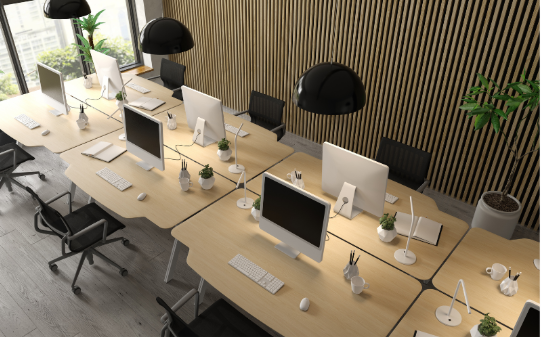Hybrid work has gained significant momentum in recent years, reshaping how businesses manage their teams and space requirements. This shift influences workplace design, including decisions about layout, technology integration, and user experience. Professionals from office interior design companies in Singapore see greater demand for versatile solutions that blend remote and on-site needs. Meanwhile, Singapore’s commercial interior design projects place greater emphasis on collaboration zones, flexible furniture, and multipurpose areas. In these changes, lab construction projects also show significant transformation, as specialists work to accommodate hybrid workflows and advanced safety regulations.
1. Changing Space Utilisation
Hybrid work encourages rethinking space allocation. Traditional rows of desks yield agile, open spaces that accommodate fluid team interactions. Office interior design companies in Singapore indicate higher demand for shared areas rather than dedicated cubicles. This approach releases underused space and channels it into communal zones where in-person meetings can happen when teams gather. The same logic applies to Singapore’s commercial interior design, where large-scale projects integrate multipurpose hubs. These spaces suit diverse activities while supporting seamless transitions from remote to on-site work.
2. Emerging Technology Tools
Technology plays a pivotal role in bridging remote and on-site teams. Video conferencing rooms now require soundproofing, advanced audio equipment, and user-friendly interfaces. Planners working on Singapore’s commercial interior design projects install integrated systems that allow effortless collaboration. In addition, occupancy sensors and digital booking platforms help businesses track usage patterns. This data informs decisions about space distribution and facility upgrades. These enhancements streamline operations and create an environment where workers feel supported. Technology remains integral in promoting efficiency within hybrid setups.
3. Greater Emphasis on Collaboration
Hybrid work compels teams to collaborate through flexible arrangements. Office interior design companies in Singapore prioritise meeting zones with adjustable furniture and interactive displays. These elements motivate employees to share ideas when they attend on-site sessions. Designers implementing Singapore’s commercial interior design integrate breakout corners, lounges, and semi-private pods to accommodate group discussions. This layout helps teams remain connected despite geographic dispersion. Regular face-to-face conversations in a well-equipped environment promote more dynamic problem-solving. Collaboration areas have become central in shaping productive work settings.
4. The Rise of Flexible Furniture
Flexible furniture supports changing headcounts in the hybrid era. Folding tables, lightweight chairs, and modular storage units give managers the freedom to rearrange spaces with ease. Office interior design companies in Singapore incorporate adaptable fixtures, which permit swift transformations. This approach provides a responsive solution when hybrid schedules bring fluctuating on-site attendance. In Singapore’s commercial interior design, partitions and reconfigurable seating let teams switch from solo tasks to group activities. This approach reflects an evolving environment that encourages creativity and comfort.
5. Shifts in Lab Construction
Hybrid arrangements have extended their impact into lab construction as well. Research facilities see greater demands for shared bench areas, remote monitoring systems, and collaborative zones. This format supports real-time data exchanges through virtual platforms while enabling hands-on sessions when necessary. Specialists designing lab construction projects focus on airflow management, material durability, and advanced safety protocols. These measures reduce disruptions and maintain high productivity levels. Flexible designs allow scientists to pivot between independent experiments and teamwork, supporting progress in evolving research landscapes.
6. Focus on Well-Being
Hybrid work highlights the need for well-being in physical spaces. Designers enhance ventilation, natural lighting, and temperature controls to promote healthier conditions. These features benefit employees who split their schedules between home and workplace. Office interior design companies in Singapore introduce greenery, acoustic panels, and ergonomic seating to reduce stress levels. In Singapore’s commercial interior design, wellness elements have become integral to project planning. Lab construction also reflects this movement, with controlled environments that reduce fatigue. A workplace that prioritises well-being supports sustained engagement.
7. Evolving Safety Standards
Hybrid work amplifies the importance of safety protocols in shared environments. In lab construction, specialists incorporate advanced ventilation systems and materials that minimise risks. Corporate offices address capacity limits by including signage and flexible scheduling to avoid overcrowding. Office interior design companies in Singapore ensure emergency exits and circulation routes remain clear and visible. These precautions help protect workers who navigate hybrid setups. In Singapore’s commercial interior design, planners coordinate with regulatory bodies to guarantee project compliance. Safety remains a vital aspect of modern interior design.
Conclusion
Hybrid work is reshaping how organisations plan offices and labs, prompting a versatile mindset in contemporary interior design and construction.
Contact Sennex Consultants now to advance your workspace transformation.
